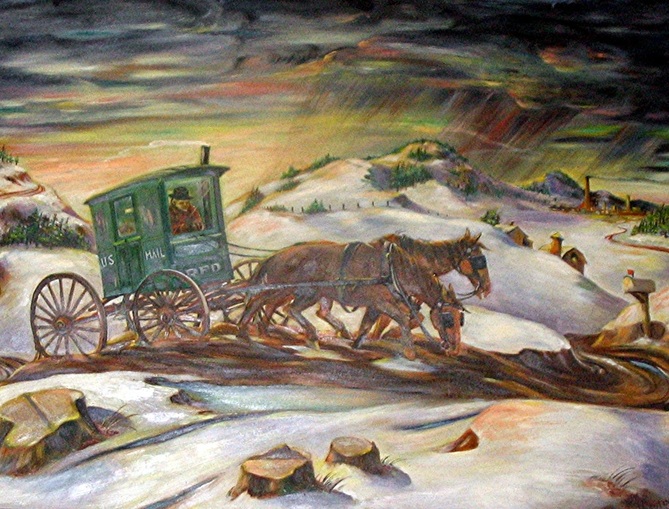Leno Prestini’s Art
Leno Prestini was an artist — a painter and sculptor — who lived the majority of his 57 years in the small town of Clayton. His surviving works were created from about 1930 until just before his suicide in 1963.
Leno sold little of his art, and those examples that did move out into the community often did so as gifts or as the results of barter.
As far as is known, Leno had no formal art training. However, since Clayton supported a once thriving terra cotta industry, this is not to say he wasn’t — in his youth at least — surrounded by artisans skilled in both sculpting and draftsmanship. It’s assumed most of his native ability was polished by his interactions with these industrial craftsmen.
As for the geneses of Leno’s approach to his paintings, of his unique style, one guess would be that he was influenced by the ‘American Regionalism’ movement that developed during the 1930s. The manner in which Leno handled Regionalism’s preference for bright colors, intense dimensional depth, and the use of sensual lines juxtaposed with strong geometrics while tending to leave out details in favor of a sense of motion and a very direct emotive sensibility does seem to accurately reflects the essence of that school. Also, the political and social elements of ‘Great Depression’ Regionalism — often reflected as anti-industrialism and anti-fascisms generally encapsulated within leftist pictorial idioms — can clearly be seen in Leno’s pre World War II canvases.
As the above suggests, many of Leno’s paintings exhibited qualities of both social conscience and childlike playfulness. Others seemed very much to be personal ciphers— outward expressions of inner conflicts usually of a romantic and/or sexual nature. His political opinions were most often expressed with sensitivity to the working-class. And still other times he expressed a love of western themes, though he did not attempt to develop these western vistas and characterizations as literal interpretations. These western paintings tend to be his most accessible and therefore popular works.
Leno’s place in the history of art has yet to be fully estimated. But regardless of what the final judgment as to Leno’s talent might be, there’s little doubt that he is a singularity in the cultural heritage of the Clayton/Deer Park community. In that regard, interest in Leno and his art will continue to be the central pillar of this area’s cultural history.
Above is Prestini’s interpretation of Clayton mailman Charles Huffman as the “Rural Mail Carrier”. Oil on canvas-board. 1947. From the Shirley Tew collection.
— Wally Lee Parker, Editor Print Publications Prestini Continues:
Leno Prestini 1
Leno Prestini 2
Leno Prestini 3
The Bogwen Report- Prestini Letters 1
The Bogwen Report- Prestini Letters 2
The Bogwen Report- Prestini Letters 3
The Bogwen Report- Prestini Letters 4
The Bogwen Report- Prestini Letters 5
Leno sold little of his art, and those examples that did move out into the community often did so as gifts or as the results of barter.
As far as is known, Leno had no formal art training. However, since Clayton supported a once thriving terra cotta industry, this is not to say he wasn’t — in his youth at least — surrounded by artisans skilled in both sculpting and draftsmanship. It’s assumed most of his native ability was polished by his interactions with these industrial craftsmen.
As for the geneses of Leno’s approach to his paintings, of his unique style, one guess would be that he was influenced by the ‘American Regionalism’ movement that developed during the 1930s. The manner in which Leno handled Regionalism’s preference for bright colors, intense dimensional depth, and the use of sensual lines juxtaposed with strong geometrics while tending to leave out details in favor of a sense of motion and a very direct emotive sensibility does seem to accurately reflects the essence of that school. Also, the political and social elements of ‘Great Depression’ Regionalism — often reflected as anti-industrialism and anti-fascisms generally encapsulated within leftist pictorial idioms — can clearly be seen in Leno’s pre World War II canvases.
As the above suggests, many of Leno’s paintings exhibited qualities of both social conscience and childlike playfulness. Others seemed very much to be personal ciphers— outward expressions of inner conflicts usually of a romantic and/or sexual nature. His political opinions were most often expressed with sensitivity to the working-class. And still other times he expressed a love of western themes, though he did not attempt to develop these western vistas and characterizations as literal interpretations. These western paintings tend to be his most accessible and therefore popular works.
Leno’s place in the history of art has yet to be fully estimated. But regardless of what the final judgment as to Leno’s talent might be, there’s little doubt that he is a singularity in the cultural heritage of the Clayton/Deer Park community. In that regard, interest in Leno and his art will continue to be the central pillar of this area’s cultural history.
Above is Prestini’s interpretation of Clayton mailman Charles Huffman as the “Rural Mail Carrier”. Oil on canvas-board. 1947. From the Shirley Tew collection.
— Wally Lee Parker, Editor Print Publications Prestini Continues:
Leno Prestini 1
Leno Prestini 2
Leno Prestini 3
The Bogwen Report- Prestini Letters 1
The Bogwen Report- Prestini Letters 2
The Bogwen Report- Prestini Letters 3
The Bogwen Report- Prestini Letters 4
The Bogwen Report- Prestini Letters 5

